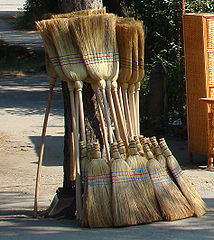The Witch’s Broom, part IV
Let’s examine the phenomenon of flying.Recall that Doreen Valiente attributes the belief that witches fly on brooms to the traditional riding-pole dance. Participants would stradle their staves and jump high to encourage the crops to grow tall. This agricultural fertility rite continued well into Christian times, with the phallic carved ends of the poles hidden by birch twigs when not in use – presumably to hide the practice from inquisitive eyes, but perhaps for some other purpose. We have already seen how during the persecutions witches were frequently said to be flying on staves rather than brooms. Maybe during the fertility rites they really were flying. Many of us modern-day witches have had the experience of dancing ecstatically during ritual and discovering that our feet were no longer touching the ground, that we were “dancing on air.”Another theory about flying has to do with “flying ointments.” These had some kind of grease as a base, with extracts of hallucinogenic plants mixed in, especially belladonna. This plant reportedly gives the user the sensation of flying. Some say the ointment was applied to the labia, so that it could be more easily absorbed through the skin. It was never used internally because belladonna and similar plants are so highly toxic. In Apuleius’ second century Latin novel The Golden Ass, the sorceress applies the ointment, assumes the form of an owl, and flies away. Other accounts of eyewitnesses say the ointment users writhed or remained inert on the floor, in an unconscious state, then wakened after about an hour reporting that they had flown. Some have conjectured that the ointment may have been applied to the broom handle, the witch rubbing her genitals against the handle until she absorbed just enough to lose consciousness. (I have a difficult time accepting this explanation, as rational as it sounds from a standpoint of safer flying.)With or without flying ointments, European shamans took trance journeys where they flew with broom-like implements. The Friulian benandanti were Christians in the sixteenth and seventeenth centuries who flew on the backs of animals carrying bunches of fennel to wield against witches bearing stalks of sorghum. Grocery store fennel looks like celery, but the plant gets quite large and rangy in the wild. Sorgham grows in large stalks that can sweep the air like a broom. Livonian Christians of the same time period assumed wolf form to fight witches who had stolen sheafs of grain. These werewolves wielded iron whips while the witches fought back with brooms. Despite their assertions that they were good people fighting bad witches, both the Friulian and Livonian shamans were persecuted by the Inquisition.Christian authorities frequently bemoaned the peasant superstition that witches used their brooms to change the weather. A witch reportedly would sweep the air with her broom to make it rain or to bring damaging storms that devastated neighbors’ crops. I’m not into storm magic myself, but many witches report that it’s fairly easy to raise winds and storms through magic. Theoretically it would be possible to raise enough wind to fly through the air, although it would take quite a bit of control to stay astride that broom, and there would be the issue of flying debris to contend with.Astral projection is yet another way to fly, one that doesn’t require a broom. I’m talking about a trance state where the body is inert but the spirit is flying in the regular world, not the otherworld. I used to do a bit of window shopping this way, especially when I lived in San Francisco. It was easier than getting around on buses. One day when I was flying in the Haight-Ashbury neighborhood, a woman walking along the sidewalk chatting to friend looked up at me and said “Oh, hello!” This is the only time this has happened to me, and I found it so disconcerting that I stopped flying for awhile. The incident proved to me that a person flying in spirit form can sometimes be noticed. Presumably, before perceptions had been distorted by modern narrow-mindedness, more people would have been able to recognize witches flying around.So there are lots of ways those legendary witches really could have been flying: trance journeys in another world, trance journeys in this world, ecstatic dancing, drug experiences. It’s too bad they’re not here to show us all the ins and outs, but at least the art of flying is still with us.SourcesApuleius. The Transformations of Lucius Otherwise Known as the Golden Ass. Robert Graves, trans. New York: Farrar, Straus and Giroux, 1951.Douglas, Adam. The Beast Within: A History of the Werewolf. New York: Avon Books, 1992.Ginzburg, Carlo. Ecstasies: Deciphering the Witches’ Sabbath. New York: Pantheon Books, 1991.Kors, Alan Charles and Edward Peters, eds. Witchcraft in Europe 400-1700. Philadelphia, University of Pennsylvania Press, 2001.Morgan, Adrian. Toads and Toadstools: The Natural History, Folklore, and Cultural Oddities of a Strange Association. Berkeley, CA: Celestial Arts, 1995.


